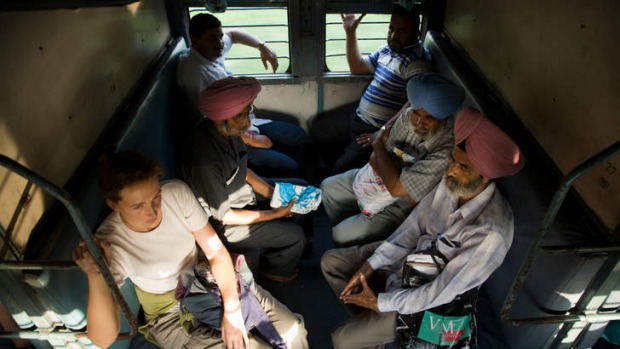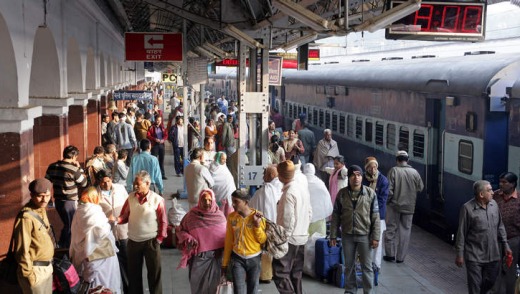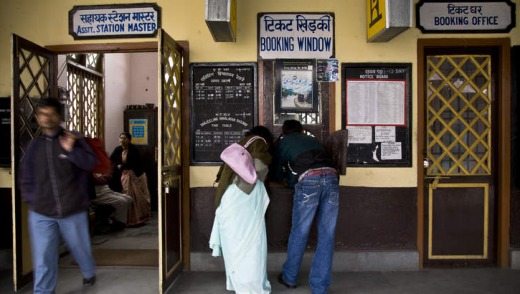
It's worth meeting the challenge of a famously chaotic rail system, writes Leisa Tyler.
Criss-crossing the bronze sands of the great Thar Desert, winding up through the lush Himalayan foothills, darting past stone monuments more than 1000 years old and skirting the edge of forests alive with tigers and lions, India has one of the most comprehensive railway systems in the world and no trip there is complete without a ride.
Transporting more than 25 million people using about 10,000 trains a day, India's rail system is a snapshot of the country; sometimes crude, other times palatial, usually noisy, reliably crowded and consistently entertaining, with any given train having a melange of campaigning politicians, students, army personnel, whole families moving city, rich, poor, young and elderly. There are book-sellers, tea-sellers, transvestites retelling poetry for small change and holy men performing puja ceremonies.

In years gone by the Maharajas owned their own trains - and their own tracks - and would travel with their staff, furniture and even elephants. But obtaining tickets and wading through Indian Railways' excruciatingly complicated bureaucracy can more often than not send travellers to the airport instead.
Here's how to book and travel by train in India with relative ease.
CHOOSE YOUR TRAIN

First, understand the classes. There are 10 different classes available on Indian trains, from two-berth first-class cabins with unobtrusive white-glove meal services to non airconditioned wooden benches.
I once took a train from Delhi to Trivandrum in the southern horn's tip in third-class sleeper. It wasn't comfortable but it did provide an intriguing insight when the whole carriage became embroiled in a lively debate on the two national pastimes - politics and cricket.
Then, understand the quotas. Aside from the general quota, all trains have special quotas that include physically handicapped, ladies, senior citizens, railway employees and so forth. Tourists can access the Foreign Tourist quota, but it cannot be booked online and must be paid for in US dollars, pounds sterling or Indian rupees with a currency exchange certificate. Then, 24 hours before the train's departure, a Tatkal quota appears - which is an allocation for last-minute bookings.
Learn the lingo. If a ticket says "CNF" it means the seat or berth is confirmed. If it says "RAC" it is reserved against cancellation. You can still travel with an RAC ticket, but may not be given a berth to sleep. "WL" means waitlisted and you cannot travel. As the most movement in ticket confirmations happen four hours before the train departs, a low number "WL" means there is a good chance of not only getting on the train but making it to CNF. If you don't have internet, check the sheet of paper stuck on the carriage door to see if your seat is confirmed.
BOOKING THROUGH THE INTERNET
Bookings for most long-distance trains open 60 days before departure. To book online, foreign nationals first need to register with Indian Railways (IRCTC). This requires having an Indian mobile phone number, where an activation code will be sent to by SMS. Another, and different, password will be sent by email.
If you don't have an Indian mobile phone number, it's possible to use a dummy (Indian mobile phone numbers start with nine, eight or seven, but the number mustn't have been used before), and email IRCTC with a copy of your passport requesting the password. Do note that IRCTC don't always answer and since the Mumbai terrorist attacks, buying a sim card in India is even more time-consuming and complicated than buying train tickets. Once registered, you can book tickets online through Indian Railways but only with an Amex card that has the SafeKey enhanced security feature. Cleartrip.com is an easier option for booking, with live updates and both Visa and Mastercard facilities.
See irctc.co.in; cleartrip.com; seat61.com.
BOOKING AT THE STATION
Brace yourself for stifling crowds, long queues and security checks, and that's even before entering the reservation room. When there, fill in a reservation form, including the train number, then take it to the reservations counter. Note that you need to fill in a separate form for any train you might want to take (since they might be fully booked). Better, book a nice hotel and ask their concierge to do the leg work for you. I have always found Taj and Oberoi hotels happy to assist for a small service fee.
See internationalrail.com.au.
BOARDING THE TRAIN
Generally, like Indian airports, passengers need to show a ticket to enter the train station, although this is not always enforced.
Your train, coach and berth number will be printed on your ticket, unless you were initially RAC or WL. In these cases, check the reservation sheet hung next to the carriage door.
The station's notice board will also have a copy of the train's reservation chart. If travelling in second or third class, it's a good idea to chain and padlock your luggage to your seat; first-class compartments are lockable from the inside. If jumping on at the World Heritage-listed Chhatrapati Shivaji Terminus in Mumbai, formerly Victoria Station, don't forget to spend a few moments admiring the station's Gothic Revival beauty.
FIVE GREAT INDIAN TRAIN JOURNEYS
TOY TRAIN
Travelling at a speed of 12km/h, the World Heritage listed Toy Train chugs from Siliguri on the flat dusty plains of West Bengal, through dense forests and past manicured tea plantations and the snow-capped peaks of Kanchenjunga to Darjeeling, the old British hill station in the foothills of the Eastern Himalayas.
HIMALAYAN QUEEN
Built in 1903 for English ladies escaping Delhi's summer heat for Shimla, this train riding on a metre-gauge railway runs through 102 tunnels, across 87 bridges and around 900 curves.
MANDOVI EXPRESS
Travelling along the Konkan Railway from Mumbai to Goa, the Mandovi has the Arabian Sea on one side and the Sahyadri Mountains on the other as it passes through 92 tunnels and across hundreds of bridges.
GOA EXPRESS
While only three hours long, this train ride offers stunning snapshots of this former Portuguese colony, inching past pristine beaches, picturesque villages of Goa before heading inland to the thick jungle of the Western Ghats.
MAHARAJA EXPRESS
Ditch the hassle of booking tickets on a public train for a trip on this privately owned train that runs multi-night journeys across Rajasthan, stopping off at the forts and palaces where empires were founded and lost.